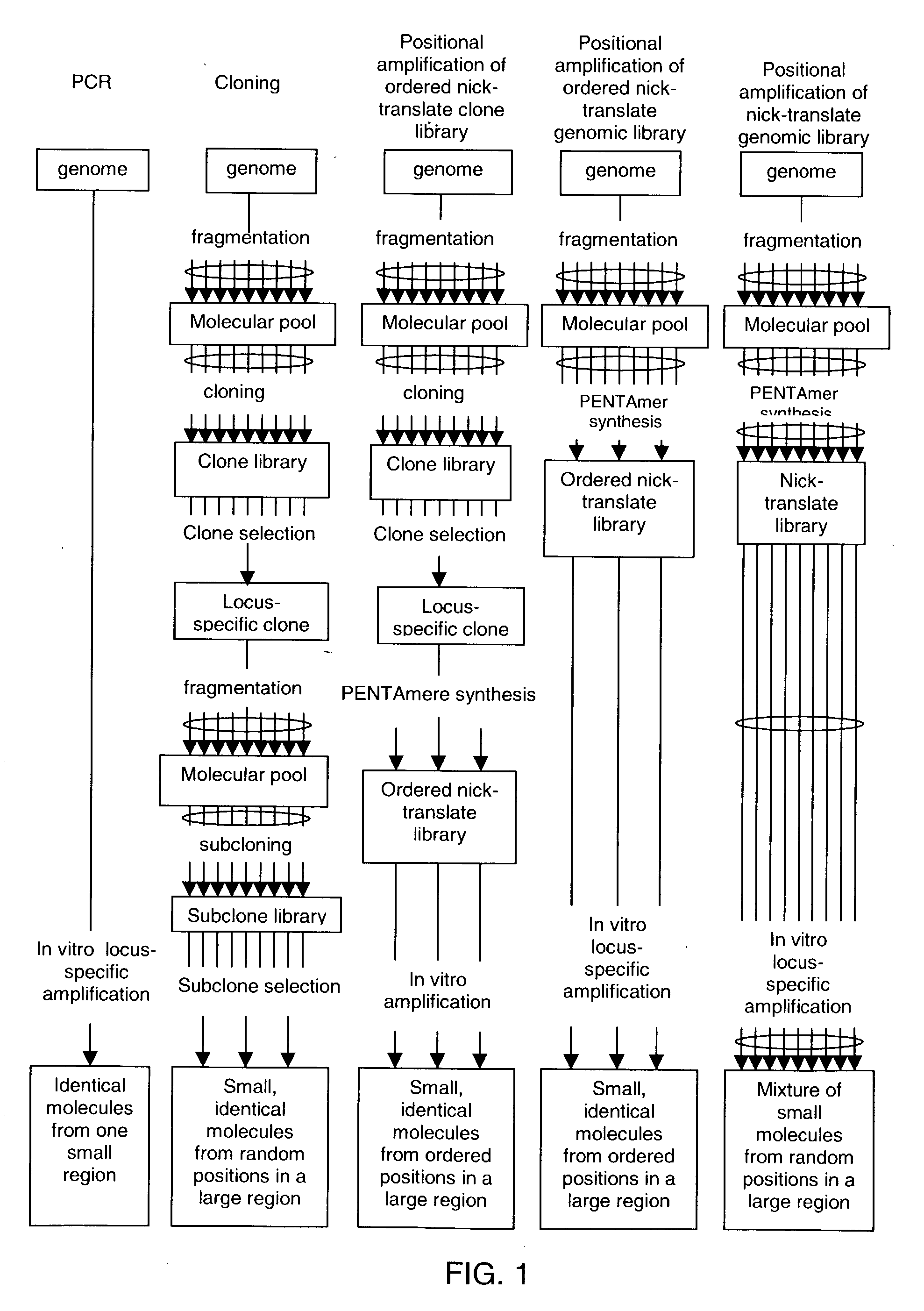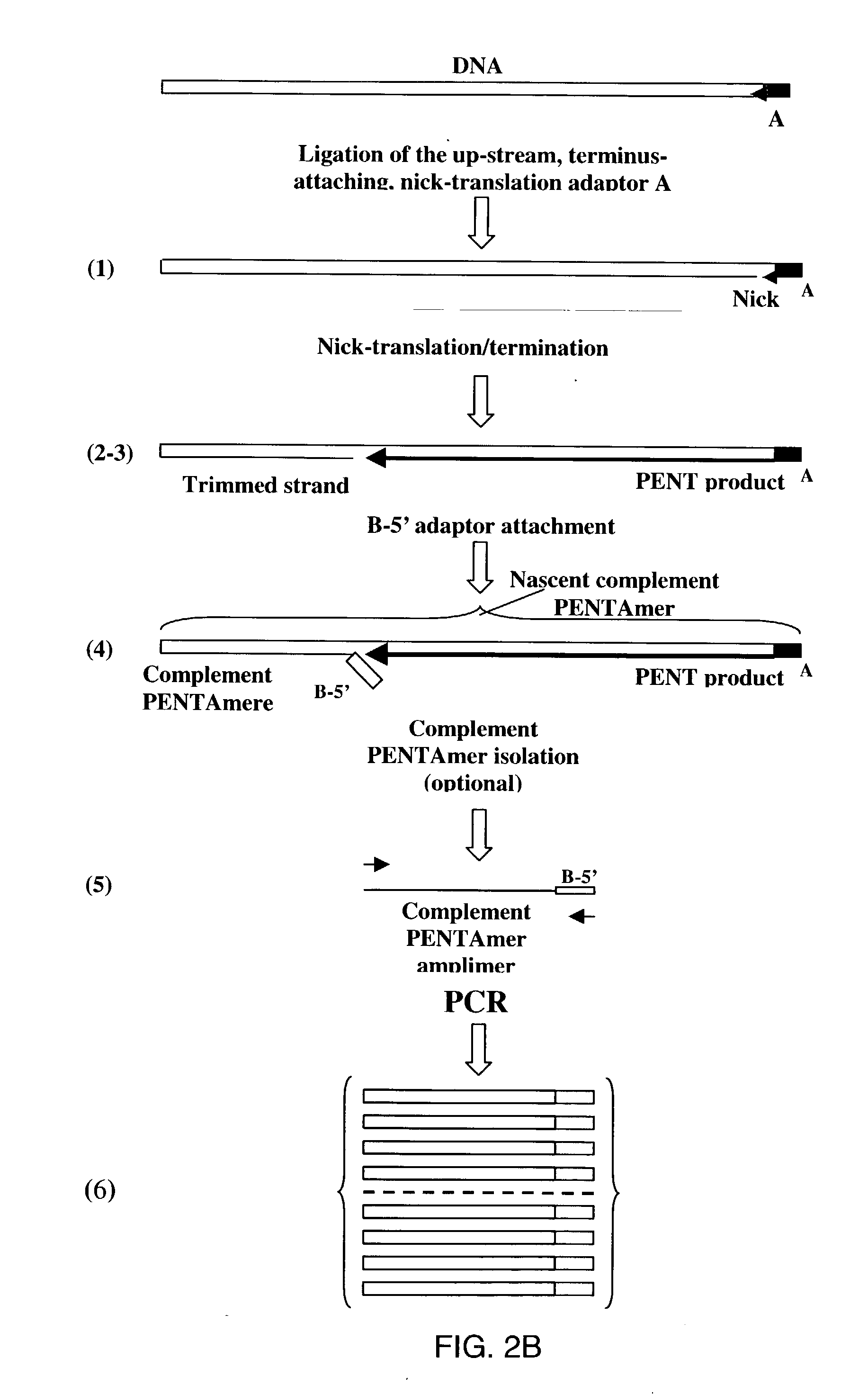Method of producing a DNA library using positional amplification
- Summary
- Abstract
- Description
- Claims
- Application Information
AI Technical Summary
Problems solved by technology
Method used
Image
Examples
example 1
Preparation of PENT Adaptors.
[0936] This example describes the preparation of several types of adaptors used in different examples for terminal and internal tagging of the double-stranded DNA molecules. Oligonucleotide sequences are shown in Table 4.
[0937] Up-stream, terminus-attaching nick-translation adaptor A (FIG. 40) is prepared by annealing 100 pmol of oligonucleotide 5608 I and 100 pmol of the oligonucleotide 5602 I by cooling from 70.degree. C. to room temperature at least 2 h in 20 .mu.l of TE-0.1 (10 mM Tris-HCl pH 8.0, 0.1 mM EDTA). The annealed oligonucleotides are incubated with 5 U of Klenow enzyme (exo.sup.-) in 40 .mu.l of 50 mM Tris-HCl, pH 7.5, 10 mM MgCl.sub.2, 1 mM DTT, 50 .mu.g / ml BSA, and in the presence of 100 mM dATP and 1 mM ddCTP at 37.degree. C. for 1 h.
[0938] Acceptor-adaptor (AC) (FIG. 40) is prepared by dephosphorylation of 10 pmol of oligonucleotide 5608 I in 10 .mu.l of 50 mM Tris-HCl, pH 8.5, 5 mM MgCl.sub.2 using 2 U of shrimp alkaline phosphatase, ...
example 2
Efficient Ligation of Blocked PENT-Adaptors.
[0945] Ligation of specialized nick-translation adaptors to the ends of DNA molecules is an important step towards the creation of a PENTAmer. This example describes the efficiency of ligation of a specialized 3'-end-blocked recombination nick-translation adaptor RA-(L-cos)(donor-adaptor Dn) with 5'phosphorylated 4-base GATC terminus to the recipient molecule (acceptor-adaptor AC) with complementary 5' termini (Example 1).
[0946] Five reaction mixtures which contain 0, 200, 400, 800 and 800 nM adaptor RA-(L-cos) (donor Dn), 200 nM acceptor-adaptor (AC) in the first four tubes (no acceptor-adaptor in tube 5), 66 mM Tris-HCl, pH 7.5, 5 mM MgCl.sub.2, 1 mM DTT, 1 mM ATP and 1 U of T4 DNA ligase (Boehringer Mannheim, Indianapolis, Ind.) in 10 .mu.l are incubated for 2 h at 20.degree. C. Tubes 6 and 7 contain ligase-deficient controls with 200 nM adaptor-acceptor and 800 nM adaptor-acceptor, respectively. The products of the ligation reactions a...
example 3
Preparation of the "PENT-ready" Lambda DNA Bam HI Templates.
[0948] This example describes the preparation of lambda DNA / Bam HI restriction fragments with upstream nick-translation adaptors A, which are used in Examples 4-7, and 9-14.
[0949] Following the incubation of 5 .mu.g of lambda DNA with 20 U Bam HI (Boehringer Mannheim, Indianapolis, Ind.) in 25 .mu.l of 10 mM Tris-HCl, pH 8.0, 5 mM MgCl.sub.2, 100 mM NaCl, 1 mM 2-mercaptoethanol for 2 h at 37.degree. C., the mixture is supplemented with 3 .mu.l of shrimp alkaline phosphatase (SAP) buffer (Boehringer Mannheim) and 2 U of SAP (Boehringer Mannheim), and incubated for 30 min at 37.degree. C. After heat inactivation of SAP at 68.degree. C. for 15 min the DNA is precipitated with ethanol, washed with 70% ethanol, dried and dissolved in 31 .mu.l TE (10 mM Tris-HCl pH 8.0, 1 mM EDTA) with a final molar concentration of Bam HI ends equal to 50 nM. Then, 5 .mu.l of SAP treated Bam HI lambda DNA restriction fragments (250 fmol ends) ar...
PUM
| Property | Measurement | Unit |
|---|---|---|
| Digital information | aaaaa | aaaaa |
| Digital information | aaaaa | aaaaa |
| Digital information | aaaaa | aaaaa |
Abstract
Description
Claims
Application Information
 Login to View More
Login to View More - R&D
- Intellectual Property
- Life Sciences
- Materials
- Tech Scout
- Unparalleled Data Quality
- Higher Quality Content
- 60% Fewer Hallucinations
Browse by: Latest US Patents, China's latest patents, Technical Efficacy Thesaurus, Application Domain, Technology Topic, Popular Technical Reports.
© 2025 PatSnap. All rights reserved.Legal|Privacy policy|Modern Slavery Act Transparency Statement|Sitemap|About US| Contact US: help@patsnap.com



